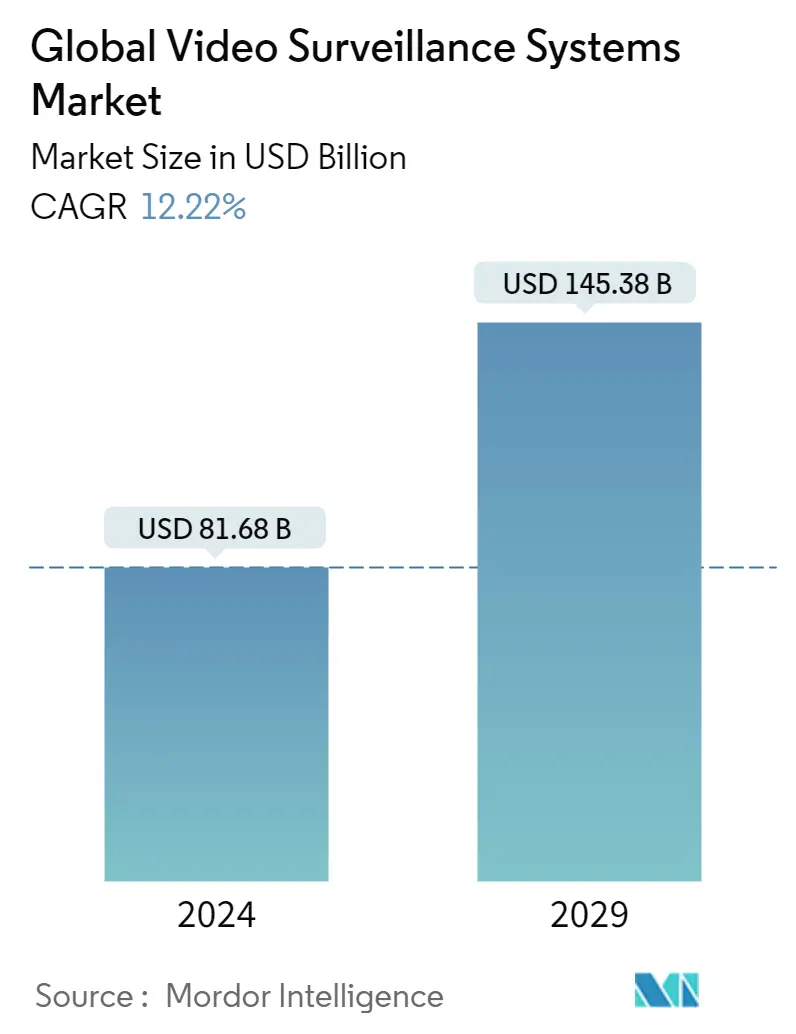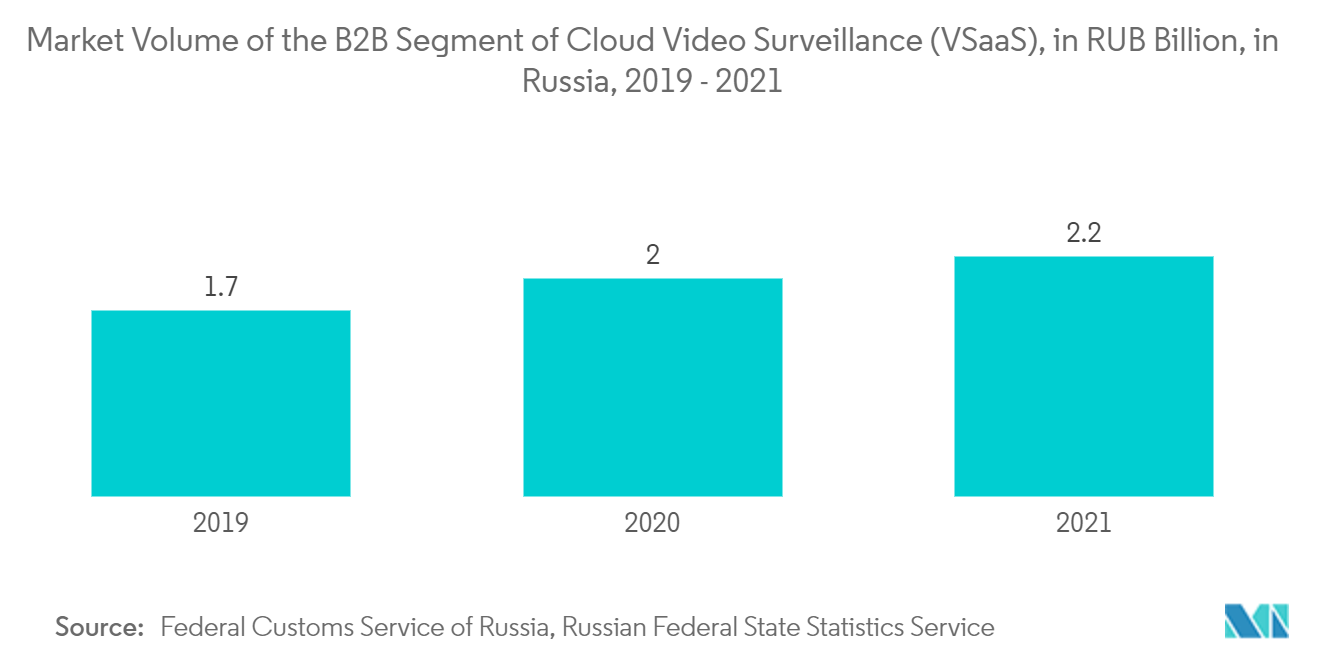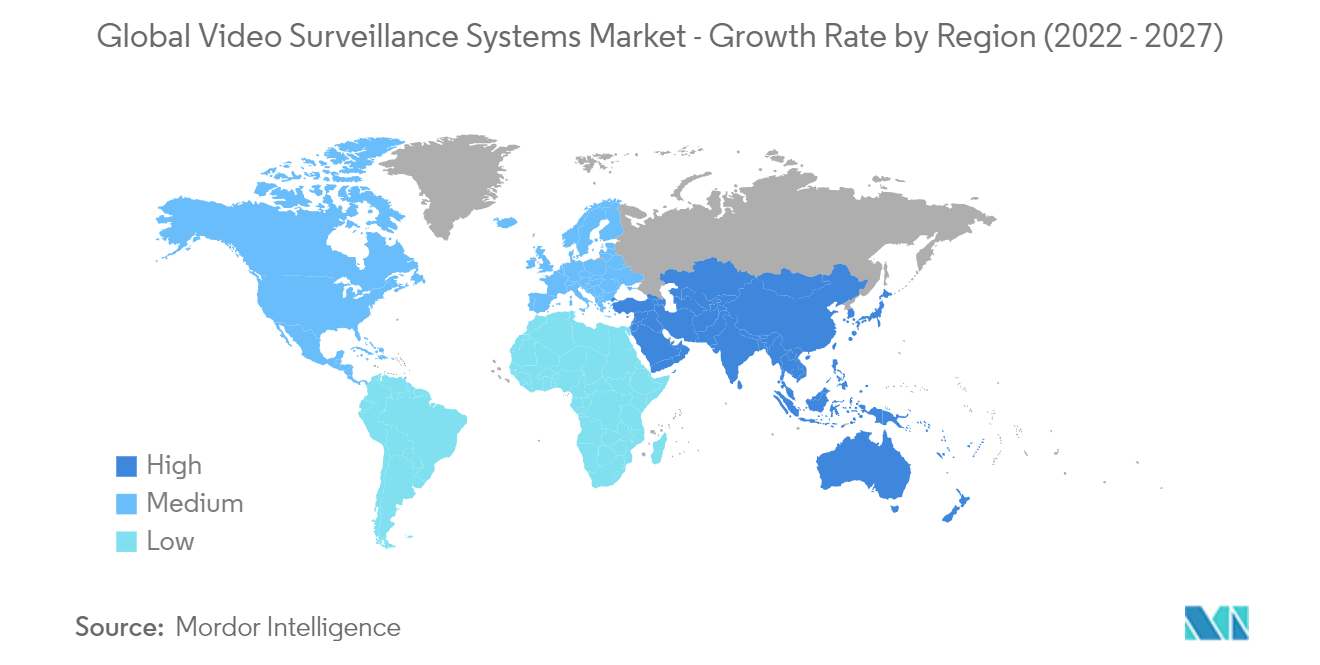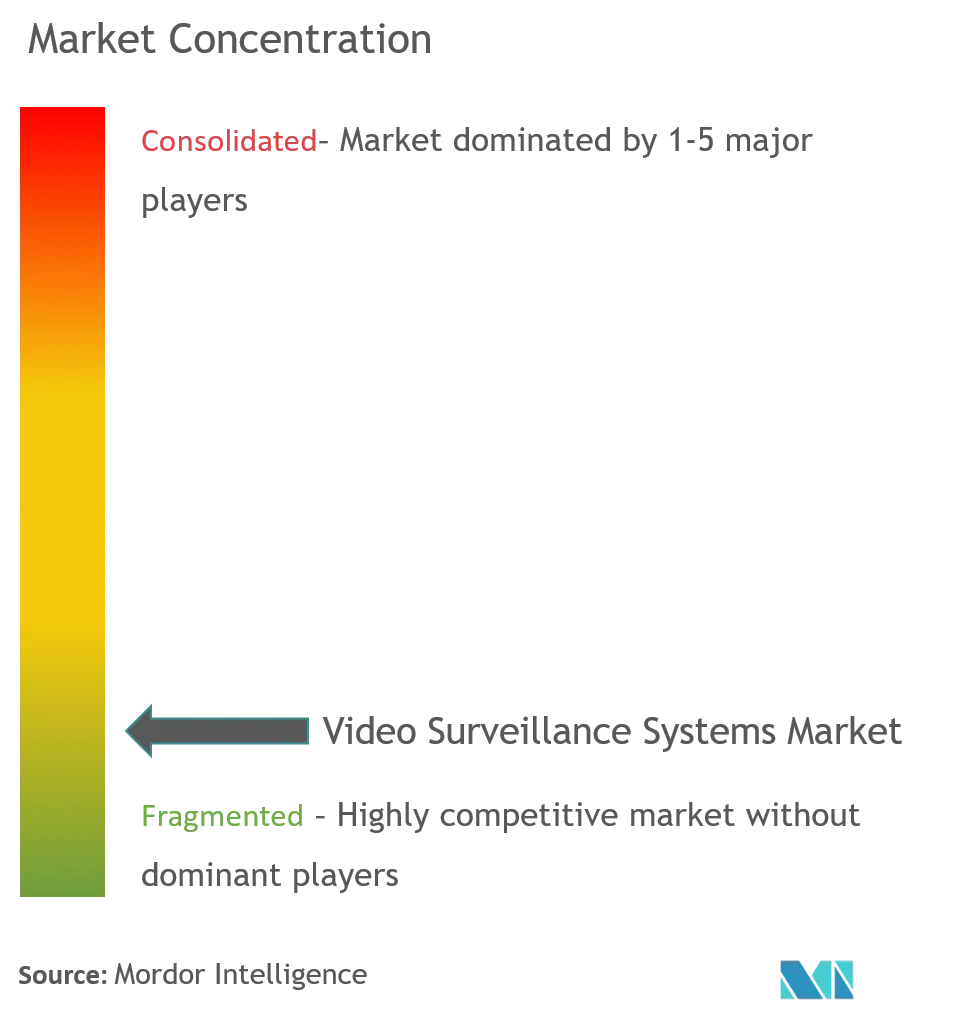Video Surveillance Systems Market Size

| Study Period | 2019 - 2029 |
| Market Size (2024) | USD 81.68 Billion |
| Market Size (2029) | USD 145.38 Billion |
| CAGR (2024 - 2029) | 12.22 % |
| Fastest Growing Market | Asia Pacific |
| Largest Market | North America |
Major Players
*Disclaimer: Major Players sorted in no particular order |
Video Surveillance Systems Market Analysis
The Global Video Surveillance Systems Market size is estimated at USD 81.68 billion in 2024, and is expected to reach USD 145.38 billion by 2029, growing at a CAGR of 12.22% during the forecast period (2024-2029).
Introducing new IP-based digital technologies to detect and prevent undesirable behaviors such as shoplifting, theft, vandalism, and terror attacks are expected to fuel the growth of the video surveillance market. Video surveillance is used in various industries, including manufacturing, banking, financial services, transportation, and retail. These methods are incorporated in nations such as the United States, the United Kingdom, India, China, and Brazil, owing mostly to the bigger scale of the concerned industries and more consumer awareness.
- T he use of video analytics and video surveillance cameras to recognize potential offenders is anticipated to help decrease crime rates in various countries. This is also expected to increase demand for an integrated surveillance system.
- In terms of adoption, VSaaS has significantly improved in recent years. This is primarily due to IP camera sales market penetration. Significant factors such as IT cost containment by major IT organizations, the emergence of data centers, and improved functionalities associated with centralized data are assisting in the growth of the VSaaS segment.
- During the COVID-19 pandemic, IP video surveillance is used primarily for various security purposes across multiple countries. These next-generation cameras feature high-performance computing power and video analytics, allowing users to transform real-time images into big data analysis. Several video analytic techniques, such as queue management, people counting, crowd detection, and personal protective equipment, have been commonly used to take precautionary measures under social distancing practices and norms.
- Furthermore, high investments in security and safety solutions by countries such as India and China aided the Asia-Pacific region in capturing the largest market share. Public safety has emerged as a critical function for governments throughout the region. As cities continue to grow, video surveillance becomes an increasingly important tool for monitoring population movement and combating crime.
- The emergence of the COVID-19 pandemic raised its usage to newer heights to limit exposure to the virus. National infrastructure, such as hospitals, monitors patient vital signs remotely through in-room video cameras and integrated telemetry systems, significantly reducing the frequency of in-person encounters between patients and medical staff.
- However, these video surveillance systems have been condemned as a violation of privacy and are opposed by a number of civil liberties organizations and activists. People are increasingly concerned about who watches the video and how it might be abused because they expect their personal information to be used only for legitimate and specific purposes.
Video Surveillance Systems Market Trends
This section covers the major market trends shaping the Video Surveillance Systems Market according to our research experts:
Infrastructure Segment is Expected to Register Significant Growth
- The infrastructure segment encompasses road, rail, airports, stadiums, etc. Technological advancements in the industry have led to the development of night vision cameras that are designed to work in low-lit areas. Infrastructure segments, particularly roads, need night-vision cameras to monitor traffic and keep track of suspicious activities. These factors are anticipated to propel the system's demand in the infrastructure segment.
- In recent years, airports have witnessed an increase in the number of terrorist attacks and intrusions activities. The prevention of unauthorized access and the early detection of suspicious activities are the most pressing security challenges for airport operators.
- Furthermore, video surveillance is one of the crucial aspects of stadium security systems since manual monitoring of individual entrants becomes difficult during large gatherings. For instance, the organizing committee of the Tokyo Olympics 2020 announced that more than 8,000 surveillance cameras are being installed across venues spread across the country. Some of the security guards are also to be equipped with wearable cameras to monitor scenes in real time.
- Departments of Transportation (DOTs) are expanding their use of job site cameras to monitor their projects, improve safety, and minimize cost overruns as demand mounts on the infrastructure business to keep up with other sectors in terms of productivity. In March 2021, EarthCam and Infotech, a leading infrastructure development software solutions provider, announced a new integration with Infotech's Doc Express service, which would send crucial visual data directly into the DOT's workflow, easing the use of visual data in project management.
- In the midst of the COVID-19, the Transportation Security Administration of the US implemented social distancing and other safety measures at airport TSA checkpoints. Deep North, a start-up based in Foster City, California, received USD 196,880 in Phase 1 funding from the Department of Homeland Security Science and Technology Directorate Silicon Valley Innovation Program in March 2021 to use video analytics in airport screening processes to significantly reduce exposure and contact between passengers and transportation security officers.
- Further, with the development of smart cameras and various associated sensors, there has been a shift toward more in-band analytics. This convergence of factors lays the strong foundation for SaaS (Software as a Service).

China in Asia Pacific is Expected to Dominate the Market
- Implementing the smart cities concept in the country is a major driving force for the video surveillance market in China. Advanced video surveillance systems have been integrated within city administration to improve efficiency. Yinchuan, China, is an example of an advanced smart city in which everything, from buses to trash cans, is incorporated into a unified system.
- The Hangzhou "City Brain" project, developed by Chinese retail and technology company Alibaba, was one of the first to use video surveillance. It uses camera systems and sensors throughout the city to collect data on road conditions in real-time. The information is fed into an AI hub, which manages traffic signals at 128 intersections and helps city officials make better decisions more quickly.
- According to a South China Morning Post article, China is making progress on a surveillance system that will connect security cameras nationwide via the cloud to a database of each individual's facial ID profile and a file of their details. The article sparked a discussion about whether the system already exists and what the potential risks are.
- The market has grown significantly in the Asia Pacific due to the increasing use of video surveillance cameras in the field of security and law enforcement, mainly to reduce the crime rate in countries like India and China. In China, cameras are primarily placed in public spaces and are funded by the government in order to deliver widespread video surveillance coverage within public areas.
- China is also a significant global driver of AI surveillance because it is home to manufacturers like ZTE, Huawei, Hikvision, and Dahua, who provide surveillance technology to over 63 countries, 32 of which have signed on to China's Belt and Road Initiative.

Video Surveillance Systems Industry Overview
Due to several key players constantly upgrading themselves to gain a competitive advantage over other players, the Global Video Surveillance Systems Market is highly competitive. Major players in the video surveillance market include Honeywell Security Group, Bosch Security Systems Incorporated, Samsung Group, Schneider Electric SE, and Panasonic Corporation, among others.
- July 2021 - Axis Communications introduced the AXIS Q6078-E PTZ Camera, which features UHD 4K resolution and a 20x zoom for exceptional video quality and wide area coverage. It features Axis Zipstream technology with H.264 and H.265 support to maintain all crucial forensic details while drastically decreasing bandwidth and storage requirements.
- July 2021 - Bosch introduced the new Autodome IP starlight 5100i IR moving camera, which features a new 1/1.8-inch sensor with 4-megapixel resolution and 30x optical zoom. It captures photographs that may distinguish individuals or objects for identification or proof by using HDR X, starlight technology, dual illumination, integrated IR, and white light.
- August 2021 - Qognify has announced Ocularis VMS version 6.1, which employs video content analytics for faster incident detection, improved real-time response, and quicker investigations. The new version incorporates Briefcam video analytics, allowing it to provide Level 4 integration for the analytics platform.
Video Surveillance Systems Market Leaders
-
Axis Communications AB
-
Bosch Security Systems Incorporated
-
Honeywell Security Group
-
Samsung Group
-
Panasonic Corporation
*Disclaimer: Major Players sorted in no particular order

Video Surveillance Systems Market News
- May 2022 - Tenda introduced the CP3 security camera in India. This security camera features pan and tilt functions and full-duplex 2-way audio communication. This security camera is aimed for use in small and home offices. The camera is an AI-powered security camera system that identifies and tracks motion. It has a full-HD 1080p image sensor that rotates 360 degrees to cover the majority of home and small office spaces.
- June 2022 - Canon India opened an experience center in New Delhi to showcase the company's full range of Network Video Surveillance (NVS) technologies. Canon's target is to become an end-to-end surveillance solutions provider and systems integrator, providing consultation and services on CCTV surveillance, access control, public address, and video analytics while addressing the entire networking and surveillance life cycle with this launch. Canon is also bringing together top surveillance industry leaders Axis, Milestone, and BCD under one umbrella to expand their NVS product range further to develop advanced video solutions in the Indian market.
- December 2021 - Axis Communications has launched an open-source video authentication project used in the company's cameras to ensure the integrity of surveillance video. Axis has released a document outlining partners' framework when deploying integrated video authentication solutions.
- September 2021 - LENSEC's Perspective Video Management Software was integrated with Bosch's Intrusion Control Panels (B and G Series). The new collaboration between the companies will allow security operators to manage intrusion, fire, and access control systems while viewing video surveillance cameras through a single pane of glass.
Video Surveillance Systems Market Report - Table of Contents
1. INTRODUCTION
- 1.1 Study Assumptions and Market Definition
- 1.2 Scope of the Study
2. RESEARCH METHODOLOGY
3. EXECUTIVE SUMMARY
4. MARKET INSIGHTS
- 4.1 Market Overview
-
4.2 Industry Attractiveness - Porter's Five Forces Analysis
- 4.2.1 Threat of New Entrants
- 4.2.2 Bargaining Power of Buyers
- 4.2.3 Bargaining Power of Suppliers
- 4.2.4 Threat of Substitute Products
- 4.2.5 Intensity of Competitive Rivalry
- 4.3 Industry Value Chain Analysis
- 4.4 Technology Snapshot
- 4.5 Impact of COVID-19 on the Market
5. MARKET DYNAMICS
-
5.1 Introduction to Market Dynamics
- 5.1.1 Market Drivers
- 5.1.1.1 Augmented Demand of IP Cameras
- 5.1.1.2 Emergence Of Video Surveillance-as-a-Service (VSAAS)
- 5.1.1.3 Increasing Demand For Video Analytics
- 5.1.2 Market Restraints
- 5.1.2.1 Need for High-capacity Storage for High-resolution Images
- 5.1.2.2 Privacy and Security Issues
6. MARKET SEGMENTATION
-
6.1 By Type
- 6.1.1 Hardware
- 6.1.1.1 Camera
- 6.1.1.1.1 Analog
- 6.1.1.1.2 IP Cameras
- 6.1.1.1.3 Hybrid
- 6.1.1.2 Storage
- 6.1.2 Software
- 6.1.2.1 Video Analytics
- 6.1.2.2 Video Management Software
- 6.1.3 Services (VSaaS)
-
6.2 By End-user Vertical
- 6.2.1 Commercial
- 6.2.2 Infrastructure
- 6.2.3 Institutional
- 6.2.4 Industrial
- 6.2.5 Defense
- 6.2.6 Residential
-
6.3 By Geography
- 6.3.1 North America
- 6.3.1.1 United States
- 6.3.1.2 Canada
- 6.3.2 Europe
- 6.3.2.1 Germany
- 6.3.2.2 United Kingdom
- 6.3.2.3 France
- 6.3.2.4 Rest of Europe
- 6.3.3 Asia Pacific
- 6.3.3.1 China
- 6.3.3.2 Japan
- 6.3.3.3 India
- 6.3.3.4 Rest of Asia Pacific
- 6.3.4 Latin America
- 6.3.4.1 Brazil
- 6.3.4.2 Mexico
- 6.3.4.3 Rest of Latin America
- 6.3.5 Middle East and Africa
- 6.3.5.1 United Arab Emirates
- 6.3.5.2 Saudi Arabia
- 6.3.5.3 Rest of Middle East and Africa
7. COMPETITIVE LANDSCAPE
-
7.1 Company Profiles
- 7.1.1 Axis Communications AB
- 7.1.2 Bosch Security Systems Incorporated
- 7.1.3 Honeywell Security Group
- 7.1.4 Samsung Group
- 7.1.5 Panasonic Corporation
- 7.1.6 FLIR systems Inc.
- 7.1.7 Schneider Electric SE
- 7.1.8 Qognify, Inc. (Battery Ventures)
- 7.1.9 Infinova Corporation
- 7.1.10 Zhejiang Dahua Technology Company Limited
- 7.1.11 Hangzhou Hikvision Digital Technology Company Limited
- 7.1.12 Sony Corporation
- *List Not Exhaustive
8. INVESTMENT ANALYSIS
9. FUTURE OF THE MARKET
** Subject To AvailablityVideo Surveillance Systems Industry Segmentation
Video surveillance systems contain one or more video cameras connected to a network that sends the captured video or audio data to a specific location. The captured images are monitored in real-time or sent to a central location for recording and storage. Many applications, such as crime prevention, industrial process monitoring, and traffic management, are increasingly utilizing video surveillance systems.
The Global Video Surveillance Systems Market is segmented by Type (Hardware (Camera (Analog, IP Cameras, Hybrid), Storage), Software (Video Analytics, Video Management Software), Services (VSaaS)), by End-user Vertical (Commercial, Infrastructure, Institutional, Industrial, Defense, Residential), and Geography.
| By Type | Hardware | Camera | Analog |
| IP Cameras | |||
| Hybrid | |||
| By Type | Hardware | Storage | |
| By Type | Software | Video Analytics | |
| Video Management Software | |||
| By Type | Services (VSaaS) | ||
| By End-user Vertical | Commercial | ||
| Infrastructure | |||
| Institutional | |||
| Industrial | |||
| Defense | |||
| Residential | |||
| By Geography | North America | United States | |
| Canada | |||
| By Geography | Europe | Germany | |
| United Kingdom | |||
| France | |||
| Rest of Europe | |||
| By Geography | Asia Pacific | China | |
| Japan | |||
| India | |||
| Rest of Asia Pacific | |||
| By Geography | Latin America | Brazil | |
| Mexico | |||
| Rest of Latin America | |||
| By Geography | Middle East and Africa | United Arab Emirates | |
| Saudi Arabia | |||
| Rest of Middle East and Africa |
Video Surveillance Systems Market Research FAQs
How big is the Global Video Surveillance Systems Market?
The Global Video Surveillance Systems Market size is expected to reach USD 81.68 billion in 2024 and grow at a CAGR of 12.22% to reach USD 145.38 billion by 2029.
What is the current Global Video Surveillance Systems Market size?
In 2024, the Global Video Surveillance Systems Market size is expected to reach USD 81.68 billion.
Who are the key players in Global Video Surveillance Systems Market?
Axis Communications AB, Bosch Security Systems Incorporated, Honeywell Security Group, Samsung Group and Panasonic Corporation are the major companies operating in the Global Video Surveillance Systems Market.
Which is the fastest growing region in Global Video Surveillance Systems Market?
Asia Pacific is estimated to grow at the highest CAGR over the forecast period (2024-2029).
Which region has the biggest share in Global Video Surveillance Systems Market?
In 2024, the North America accounts for the largest market share in Global Video Surveillance Systems Market.
What years does this Global Video Surveillance Systems Market cover, and what was the market size in 2023?
In 2023, the Global Video Surveillance Systems Market size was estimated at USD 72.79 billion. The report covers the Global Video Surveillance Systems Market historical market size for years: 2019, 2020, 2021, 2022 and 2023. The report also forecasts the Global Video Surveillance Systems Market size for years: 2024, 2025, 2026, 2027, 2028 and 2029.
Video Surveillance Industry Report
The global Video Surveillance as a Service market is characterized by a comprehensive market analysis that includes segmentation by type, end-user vertical, and geography. The market report highlights the significant market growth expected in the coming years, driven by advancements in hardware, software, and services. The industry report provides an in-depth industry overview, focusing on the contributions of various market leaders and the evolving market trends.
The market research indicates a robust market forecast, with industry statistics pointing to substantial growth in market size. This growth is attributed to the increasing adoption of video surveillance technology across commercial, infrastructure, institutional, industrial, defense, and residential sectors. The industry analysis underscores the importance of video analytics and video management software in enhancing the functionality and efficiency of surveillance systems.
The market segmentation analysis reveals that IP cameras and hybrid cameras are gaining traction, while the demand for analog cameras is declining. The market outlook suggests that the industry will continue to evolve, with significant investments in research and development driving innovation and market value.
Industry reports provide valuable insights into market data, highlighting the market leaders who are setting the pace in technology adoption and market expansion. The market review emphasizes the importance of understanding market trends to stay competitive. The industry research also sheds light on the market's growth rate, which is a critical factor for stakeholders to consider.
The report example and report PDF available offer a detailed market review and industry outlook, providing a comprehensive understanding of the market's current state and future predictions. The market segmentation further breaks down the industry size and market value, offering a clear picture of the market's potential.
In conclusion, the video surveillance as a service market is poised for significant growth, driven by technological advancements and increasing demand across various sectors. The market data and industry statistics provided in the industry reports and research companies' analyses offer a solid foundation for strategic planning and decision-making.



